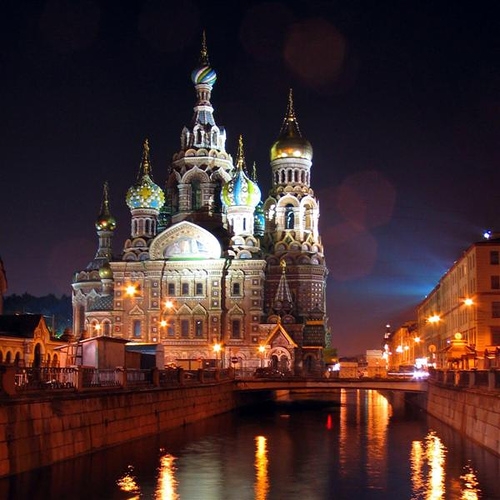St. Petersburg, often referred to as the Venice of the North, is truly a remarkable city. Whether during the white nights of summer – the sun doesn’t set until after 10 pm each night from March to late August) or the special charm of the white days of winter (from November 1 to March 31), the city’s remarkable beauty and vibrancy captivates residents and visitors alike. St. Petersburg is truly one of the great architectural wonders of the world.
Founded in 1703 by Czar Peter the Great to modernize Russia’s economy by forming a closer economic, cultural and technical bond with Europe, St. Petersburg was built in only nine years and became the capital of Russia in 1712. The wide Neva River and many other smaller rivers and manmade canals organically blended into the cityscape and determined the size and direction of its main avenues.
After the Russian Revolution in 1917, communists moved the capital to Moscow and changed the name of the city to Leningrad. World War II was not kind to Leningrad. The 1-day Nazi siege is one of history’s great tragedies. Hundreds of thousands of citizens perished from the cold, starvation and bombardment, but the city survived and triumphed. Reconstruction of the city’s industry, public works, museums and libraries began almost immediately after the siege broke. Today, St. Petersburg is Russia’s second largest city. The population currently stands at 4.6 million. The city is growing fast, its historic center surrounded by modern office centres, shopping malls, hotels and hyper-markets, as investment floods in from Russian and foreign banks.
We arrived by overnight train from Moscow. We were in a sleeper car for four, which was roomy and comfortable. The seats easily rolled into beds – with two bunks on top on each side. The cherry red train left Moscow at midnight and arrived promptly at 8 am the next day. The washrooms on board were clean and modern. We were given bed-wear and a snack box with yogurt, fruit, cheeses, meats and oils. The Russian train staff was very friendly and helpful with boarding and un-boarding. (In April, the Russian government announced that a new high-speed train between Moscow and St. Petersburg will be in service by 2010, reducing travel time to three hours.)
The first thing we noticed about St. Petersburg is the clean and modern Moskovsky train station in the heart of the city. (If only we had a centrally located train station in Ottawa!) The coffee bars were busy as we left the station to depart for The Grand Hotel Europe, one of the oldest and most esteemed hotels in the world. After checking in, we met over espresso in the Mezzainine Cafe to plan our day. We decided to attend several museums, but how to choose from among no less than 250 museums in St. Petersburg? The city is rightfully proud to be the home of the Hermitage and the Russian Museum, which are among the largest museums in the world. The Hermitage’s collection of art surpasses that of the Louvre! It occupies five historical buildings in the city centre, including the Winter Palace, once the czar’s official residence. One can easily spend a week taking in all the Hermitage has to offer but our very articulate and informed guide showed us the highlights during our eight-hour visit.
St. Petersburg is one of the great cultural capitals of the world. The only thing that seems to be more exciting that its past is its future, as it undergoes a modern renaissance.
The GRAND HOTEL EUROPE – St. Petersburg
A Member of The Leading Hotels of the World
The Grand Hotel rakes up almost an entire city block. Its architecture is drawn from the 18th century imperial traditions of France and Austria. The hotel was the centre of social activity and hosted famous writers, academics actors and royalty from around the world during its heyday in the 19th century. The communists closed the hotel after the 1917 Revolution and used it as a meeting place for the local trade union and as a school for orphans. It served as a hospital during the siege of Leningrad in World War II. In the post war years, the building once again served as a hotel, run by Soviet officials but a pale shadow of its former self. This all changed when the Soviet Empire collapsed. By 1989, the old hotel had closed for reconstruction, reopening in 1991 as the first five-star hotel in the New Russia. By 1995, The Grand Hotel Europe was recognized as the best hotel in Russia and named a member of The Leading Hotels of the World. This excellence was clearly recognized in 2005 when the famous Orient-Express Hotel Corporation purchased the entire property to be in their stable of global five-star properties. The Grand Hotel has seven restaurants, including Russia’s leading fine dining establishment, L’Europe Restaurant. The hotel has a fitness centre, business centre, banquet and conference rooms, Internet hook-ups and all the modern amenities. Then there is just the architectural beauty and history of the place. Oddly enough when we were visiting so was Mikael Gorbachev. The hotel often has celebrity guests and is sensitive to their security needs while ensuring that their presence doesn’t impact negatively on other guests. A member of Gorbachevs entourage told us that of all the hotels he stays at in the world, The Grand Hotel Europe in St. Petersburg is still his favourite!

